*My posts may contain affiliate links, which means I may receive a small commission, at no cost to you, if you make a purchase through a link! Thank you for supporting my website!*
Last updated on February 28th, 2024 at 04:25 pm
Have you ever wondered if you can mix stain colors? Well, look no further because I have your answer!
Mixing stain colors create custom colors that add uniqueness to wood projects. Custom stain colors help your wood project better complement other colors within your home by minimizing the natural wood tones (red, brown, yellow) in some colors and enhancing the neutral tones (gray, black, white) in others.
For example, mixing 50% brown stain and 50% gray stain creates a more modern gray-brown stain that cannot be bought in store.
I really wanted a more gray-brown color for our floating fireplace mantel, so I decided to run this experiment to figure out what happens when you mix stain colors.
This post will demonstrate what I found!
Now that I’ve figured out how to mix custom stain colors, I know that I can always find the perfect color to complement the project I’m working on. And after you see my mixing process/ results, you’ll be able to also.
Below, I broke down the different custom colors I created and how I mixed them (I even used 4 different stain colors!).
Hopefully, this will help you determine which custom stain color is best for your next wood project. (Or how you could create your own custom color!)
Let’s dive in!
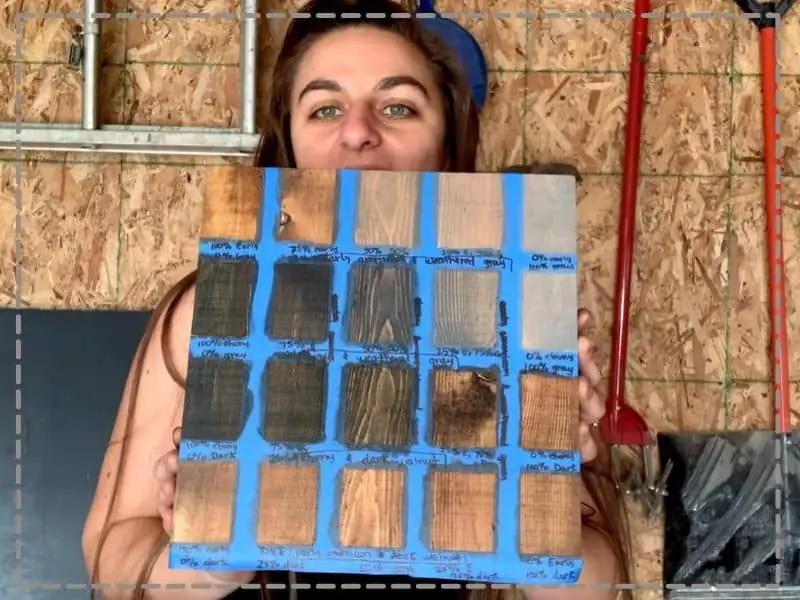
Quick Navigation: Mixing Stain Colors
- Mixed Stain Color Chart Using Varathane Fast Dry Wood Stain On Pine
- Stain Mixing Ratios
- Early American & Weathered Gray Custom Stain Mixture Recipes
- Ebony & Weathered Gray Custom Stain Mixture Recipes
- Ebony & Dark Walnut Custom Stain Mixture Recipes
- Early American & Dark Walnut Custom Stain Mixture Recipes
- Other FAQs About Mixing Stains
- Final Thoughts
Mixed Stain Color Chart Using Varathane Fast Dry Wood Stain On Pine
To determine what happens when you mix stain colors, I used 4 different colors of Varathane Fast Dry Wood Stain on a sanded piece of pinewood.
I absolutely love this stain found at Amazon because it dries in 1 hour and is ready to be top-coated!
(Unlike other stains that take 2 hours all the way up to 24 hours to dry before being top-coated. I don’t know about you, but I don’t have time for that!)
Plus, this stain leaves a rich color with a single coat of stain, which is another time-saver. That’s what we’d call a win-win around here!
So I always opt for this brand of stain for my wood projects.
The Varathane colors I used to mix my custom colors include Early American, Weathered Gray, Ebony, and Dark Walnut.
Here is a picture of how all of the various color mixtures turned out!
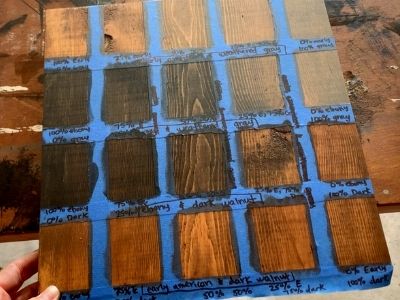
My all-time favorite custom color is 50% Early American and 50% Weathered Gray because it creates a gorgeous and modern gray-brown stain.
This color mixture complements my mostly gray, black, and white home perfectly.
Stain Mixing Ratios
No matter what colors you mix, you’ll want to mix them in a measured out fashion (ex. 25% one color 75% the other color, 50%-50%, etc.).
That way, you can replicate the recipe in the future! (Or on the off chance that you don’t mix enough the first time for your current project. You know, it happens to the best of us haha!)
You can do this by using a plastic spoon or an old tablespoon or anything else you can come up with to make the measurements equal.
Alright, let’s discuss the custom colors I made!
Early American & Weathered Gray Custom Stain Mixture Recipes
The different mixtures I made from Early American and Weathered Gray were my favorite.
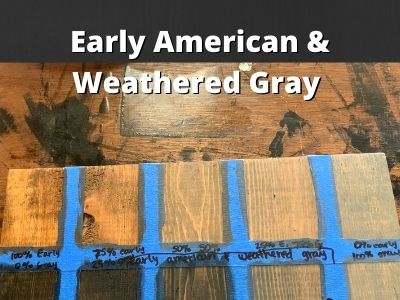
Early American stain is a lighter walnut that naturally brings out the gorgeous woodgrain in pine.
When Early American stain is mixed with the more opaque Weathered Gray stain, it changes from a strong brown color to a gray-brown color.
That makes this color perfect for your home if you have a strong contemporary style.
Grays are in, so mixing a wood stain that complements the grays in your home is an excellent move.
That’s exactly why we mixed a custom color for our floating fireplace mantel. 50% Early American mixed with 50% Weathered Gray makes this beautiful color!
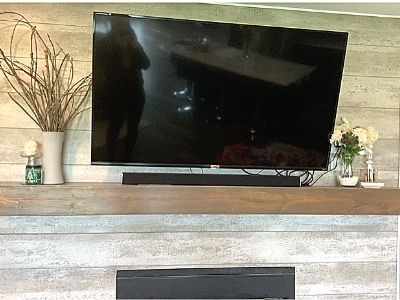
(P.S. If you want to make a floating mantel just like ours for cheap, you should check out my tutorial here. Regular fireplace mantels that look just like this cost $350+.
I said no way! I made mine for less than $60, and it’s something that I’m proud to tell guests that I made!)
As you mix these colors, add a little more Early American stain for a more brown color, or a little more Weathered Gray stain for a more rustic gray color.
Ebony & Weathered Gray Custom Stain Mixture Recipes
The next two colors I mixed together were Ebony and Weathered Gray.
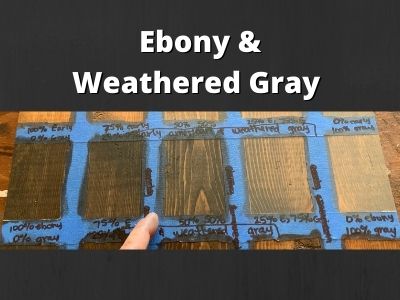
Both Ebony stain and Weathered Gray stain are opaque – meaning that they don’t let the wood grain shine through as well as the other more yellow or brown colors.
So that makes any of these mixtures perfect for you if you aren’t a huge fan of prominent woodgrains.
Mixing Ebony and Weathered Gray stain also would go fabulous in your home if blacks and grays are strong accent colors throughout your home.
Imagine some gorgeous wood tables or stools in the 50% Ebony and 50% Weathered Gray mixture!
As you mix these colors, add a little more Ebony stain for a more prominent black color or add a little more Weathered Gray stain for a more prominent gray color.
Ebony & Dark Walnut Custom Stain Mixture Recipes
The next two colors I mixed together were Ebony and Dark Walnut.

Mixing Ebony Stain with Dark Walnut stain is perfect to darken a dark walnut even further and pull in the more modern blacks and grays into the stain.
If you haven’t noticed, I love mixing brown stains with black or gray stains.
I think they complement each other wonderfully because the browns highlight those gorgeous woodgrains while the blacks/grays pull in that more contemporary, muted look!
If you felt like the Early American and Weathered Gray stain mixture was still too light for you, then mixing Ebony and Dark Walnut could be the answer.
(Or mixing Dark Walnut and Weathered Gray stain could be an excellent custom gray-brown stain mixture!
I didn’t test that color combo, but it also would create that gray-brown color that’s darker than the Early American version would bring.)
Any of these color mixtures would look fantastic on wood shelves with a bright white wall behind them!
Just like the other colors, mix a little bit more Ebony stain for a more prominent black color or mix a little bit more Dark Walnut stain for a more prominent brown color.
Early American & Dark Walnut Custom Stain Mixture Recipes
The last custom stain mixture I tried was Early American and Dark Walnut.
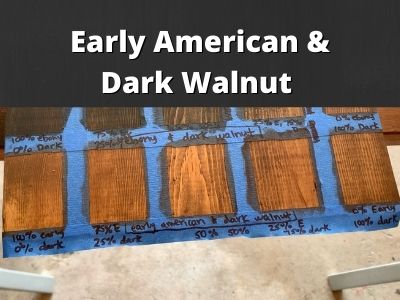
Now, you might be laughing at me for mixing two brown stains that are relatively close in color, and it’s okay. I’m laughing too.
All of these colors turned out almost exactly the same haha! Of course, that’s probably not surprising to some.
But to me, I had to make sure I wasn’t missing out on a really pretty color combo.
The beauty behind me spending the time to make this mix is that now you don’t have to wonder about how it would turn out!
The best stain mixture recipes involve mixing more opaque colors like Ebony or Weathered Gray (or other gray, black, or white stain colors) with less opaque colors like Early American or Dark Walnut (or other natural wood-toned stain colors).
I loved doing these experiments because now I can keep this piece of pine and determine which custom color would be perfect for my next wood project!
Of course, I’m sure you have a few other questions about staining as I have over time, so check out these FAQs to build your staining knowledge base.
Other FAQs About Mixing Stains
Here are some other frequently asked questions about stain and polyurethane applications to help you create the most flawless wood projects!
How Long Should Stain Dry Before Applying Polyurethane?
Here is a list of the most popular stains and how long you should let the stain dry before applying polyurethane.
(This is why Varathane Fast Dry Wood stain found at Amazon is my favorite! It has one of the fastest drying times with one of the richest colorings!)
| Stain Brand | Dry Time Before Applying Polyurethane |
|---|---|
| Varathane Fast Dry Wood Interior Stain | 1 Hour |
| Varathane Classic Wood Interior Stain | 8 Hours |
| Minwax Wood Finish | 4-6 Hours |
| Minwax Gel Stain | 24 Hours |
| General Finishes Oil-Based Interior Wood Gel Stain | 24 Hours |
| Rust-Oleum Ultimate Stain | 1 Hour |
| BEHR Water-Based Fast Drying Interior Wood Stain | 1 Hour |
| ZAR Oil-Based Multi-Surface Interior Wood Stain | 3 Hours |
Can I Mix Wood Stains?
Wood stains of the same type can be mixed together to create custom colors. Oil-based wood stains should only be mixed with other oil-based stains and water-based wood stains should only be mixed with other water-based stains.
How Do You Mix Wood Stains To Get The Color You Want?
To mix wood stains to get the color you want, use a 50/50 or 25/75 ratio to ensure the custom color can be duplicated if necessary. For example, mix 50% of one color with 50% of another color or 25% of one color and 75% of another color. Use disposable cups and measuring cups to measure out the appropriate stain amounts for the ratios.
Can I Dilute Wood Stain?
Wood stain can be diluted to make the color lighter. To dilute an oil-based wood stain, use mineral spirits. To dilute a water-based wood stain, use water. Mix small amounts of water or mineral spirits with the stain until you get the desired color.
Can You Mix Gray And Brown Stain?
Gray and brown stains can be mixed to create a modern, beautiful, and unique color. The brown stain highlights the woodgrains while the gray stain pulls in a more contemporary, muted undertone that complements many household color schemes.
Will Two Coats Of Stain Make It Darker?
Two coats of stain will make the stain appear darker because the application of the second coat creates a deeper pigment on the wood. The second coat of stain can help minimize blotchiness or unevenness in color during the stain application process.
How To Get Rid Of Bubbles In Polyurethane (& Other Polyurethane Mistakes To Avoid)
After you’ve worked so hard to perfect your stain color, you need to seal your wood project with polyurethane.
While polyurethane is not hard to use once you get the hang of it, it does have a few nuances you’ll want to be aware of before you ruin a perfectly good stained wood project.
Check out my tutorial on how to get rid of bubbles in polyurethane (and other polyurethane mistakes to avoid) to help finish off your beautiful wood project like a pro!
Final Thoughts On Mixing Stain Colors To Make Custom Colors
There you have it! Mixing custom stain colors is an excellent way to achieve the perfect color for your unique wood project and home.
I know it’s a little bit more work than the standard color from the store, but sometimes the little bit of extra work is worth the big reward!
At least, we thought so on our floating fireplace mantel haha!
Catch you in my next post!
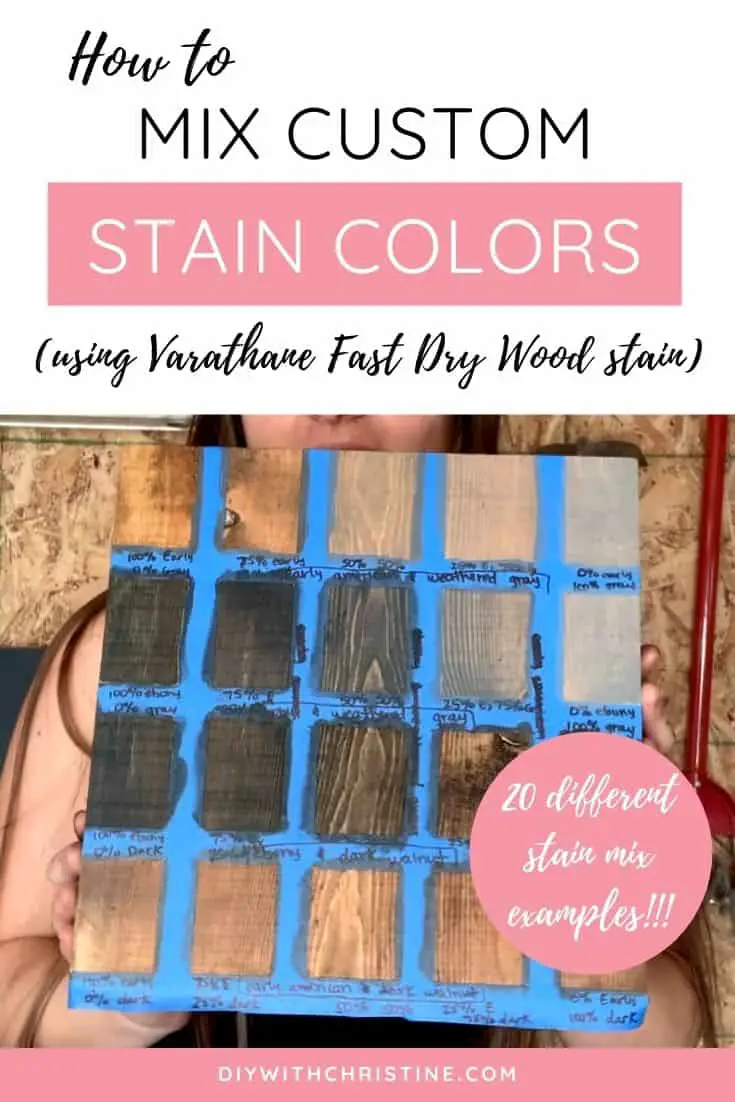

By Christine
Christine is a blogger and DIYer who tackles home renovation and decorating projects alongside her husband, Adam, for their personal residence and rental properties. Although she successfully tackles large renovation projects to avoid expensive contractor fees and bring her vision to life now, her path to success was not easy.
Go here to read her story, “From a Clueless First-Time Homebuyer To A Confident DIYer Creating Her Dream Home One Project At A Time“.
Popular Posts
DIY With Christine is a participant in the Amazon Services LLC Associates Program, an affiliate advertising program designed to provide a means for sites to earn advertising fees by advertising and linking to Amazon.com.





